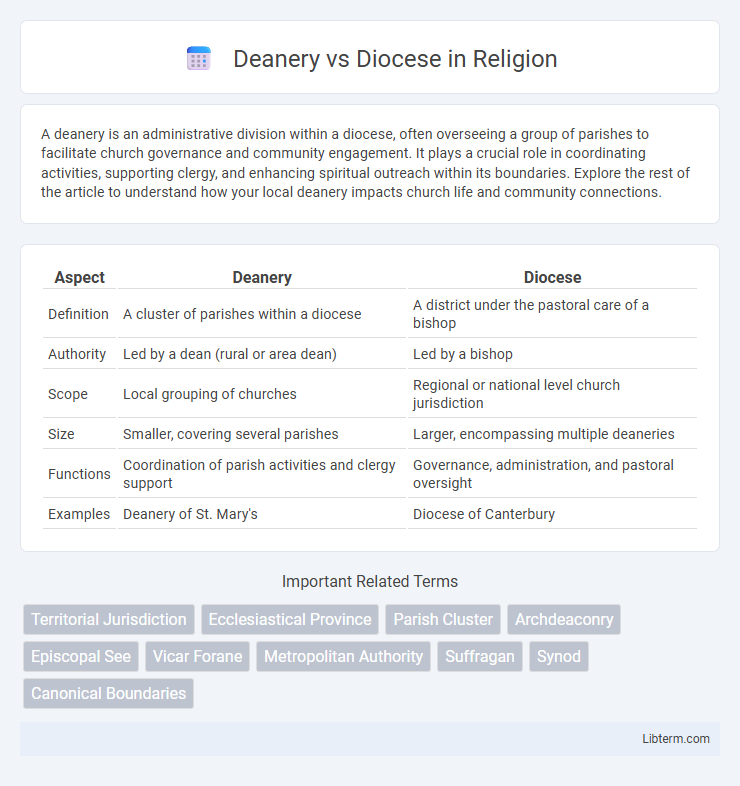A deanery is an administrative division within a diocese, often overseeing a group of parishes to facilitate church governance and community engagement. It plays a crucial role in coordinating activities, supporting clergy, and enhancing spiritual outreach within its boundaries. Explore the rest of the article to understand how your local deanery impacts church life and community connections.
Table of Comparison
| Aspect | Deanery | Diocese |
|---|---|---|
| Definition | A cluster of parishes within a diocese | A district under the pastoral care of a bishop |
| Authority | Led by a dean (rural or area dean) | Led by a bishop |
| Scope | Local grouping of churches | Regional or national level church jurisdiction |
| Size | Smaller, covering several parishes | Larger, encompassing multiple deaneries |
| Functions | Coordination of parish activities and clergy support | Governance, administration, and pastoral oversight |
| Examples | Deanery of St. Mary's | Diocese of Canterbury |
Definition of a Deanery
A deanery is a territorial subdivision within a diocese, comprising several parishes grouped together for administrative and pastoral purposes. It is overseen by a dean, who coordinates activities and supports clergy within the deanery, acting as a liaison between parish priests and the diocesan bishop. Unlike a diocese, which is a larger ecclesiastical district under the jurisdiction of a bishop, a deanery functions as an intermediate structure to facilitate local church governance and community engagement.
Definition of a Diocese
A diocese is a district under the pastoral care and jurisdiction of a bishop in the Christian Church, serving as the primary organizational unit for managing multiple parishes within a specific geographic area. It functions as a significant ecclesiastical territory that oversees spiritual guidance, administrative duties, and church governance. In contrast, a deanery is a subdivision of a diocese, grouping several neighboring parishes under the supervision of a dean to facilitate local administration and coordination.
Historical Origins of Deaneries and Dioceses
Deaneries and dioceses have distinct historical origins rooted in the organizational evolution of the Christian Church. Dioceses originated as administrative regions governed by bishops, tracing back to the early Roman Empire's territorial divisions adapted by the Church to oversee ecclesiastical jurisdictions. Deaneries emerged later as subunits within dioceses, led by deans who coordinated groups of parishes, reflecting the need for more localized church governance during the Middle Ages.
Structural Hierarchy: Deanery vs Diocese
A diocese is a primary ecclesiastical jurisdiction overseen by a bishop, encompassing multiple parishes within a defined geographic area. A deanery is a subdivision within a diocese, grouping several neighboring parishes under the supervision of a dean to facilitate local administration and pastoral coordination. The structural hierarchy places the diocese as the broader organizational unit with comprehensive authority, while the deanery functions as an intermediate level to support parish management and connectivity within the diocese.
Roles and Responsibilities Within a Deanery
A deanery functions as a subdivision within a diocese, grouping several parishes under the leadership of a rural dean who coordinates pastoral care, administrative duties, and local mission initiatives. The deanery facilitates communication between parish clergy and the diocesan bishop, ensuring consistent implementation of diocesan policies and support for clergy and lay members. Responsibilities include organizing clergy meetings, promoting spiritual development, and managing shared resources among the parishes to strengthen community outreach and church growth.
Roles and Responsibilities Within a Diocese
A diocese is a large ecclesiastical district under the jurisdiction of a bishop responsible for overseeing all churches and clergy within its territory. A deanery is a subdivision of a diocese, managed by a dean who coordinates activities among neighboring parishes, facilitating communication and support between the bishop and local congregations. The diocese handles broad administrative, pastoral, and doctrinal matters, while the deanery focuses on localized supervision, collaboration, and resource sharing among parishes.
Leadership: Dean vs Bishop
A dean oversees a deanery, providing leadership to a group of parishes within a specific region of a diocese, focusing on administrative coordination and pastoral support. A bishop leads the entire diocese, possessing ecclesiastical authority over all deaneries and parishes, responsible for ordination, doctrinal guidance, and overarching spiritual governance. The bishop's role is hierarchical and sacramental, while the dean serves as an intermediary leader enhancing local church collaboration.
Geographic Scope and Organization
A diocese represents a large ecclesiastical territory led by a bishop, encompassing multiple deaneries, which are smaller administrative subdivisions within the diocese. Deaneries function as clusters of parishes grouped based on geographical proximity, facilitating more localized governance and pastoral care. The geographic scope of a diocese spans an extensive region, often covering cities or entire counties, while a deanery's scope is limited to a fraction of that area, ensuring efficient management and community coordination.
Interactions Between Deanery and Diocese
Deaneries function as subdivisions within a diocese, facilitating localized administration and closer pastoral care by grouping parishes under a dean's supervision. They serve as critical liaison points between parish communities and the diocesan bishop, enabling efficient communication, resource allocation, and implementation of diocesan policies. By coordinating activities and addressing regional issues, deaneries support the diocese's broader mission while maintaining a direct connection with individual parishes.
Importance in Modern Church Administration
Deaneries serve as vital subdivisions within dioceses, enabling more efficient oversight and localized pastoral care in modern church administration. Dioceses, led by bishops, hold primary authority over church governance, encompassing multiple deaneries to coordinate broader strategic initiatives and resource allocation. The hierarchical relationship between deaneries and dioceses ensures effective communication, accountability, and adaptation to community needs within the contemporary ecclesiastical structure.
Deanery Infographic

 libterm.com
libterm.com